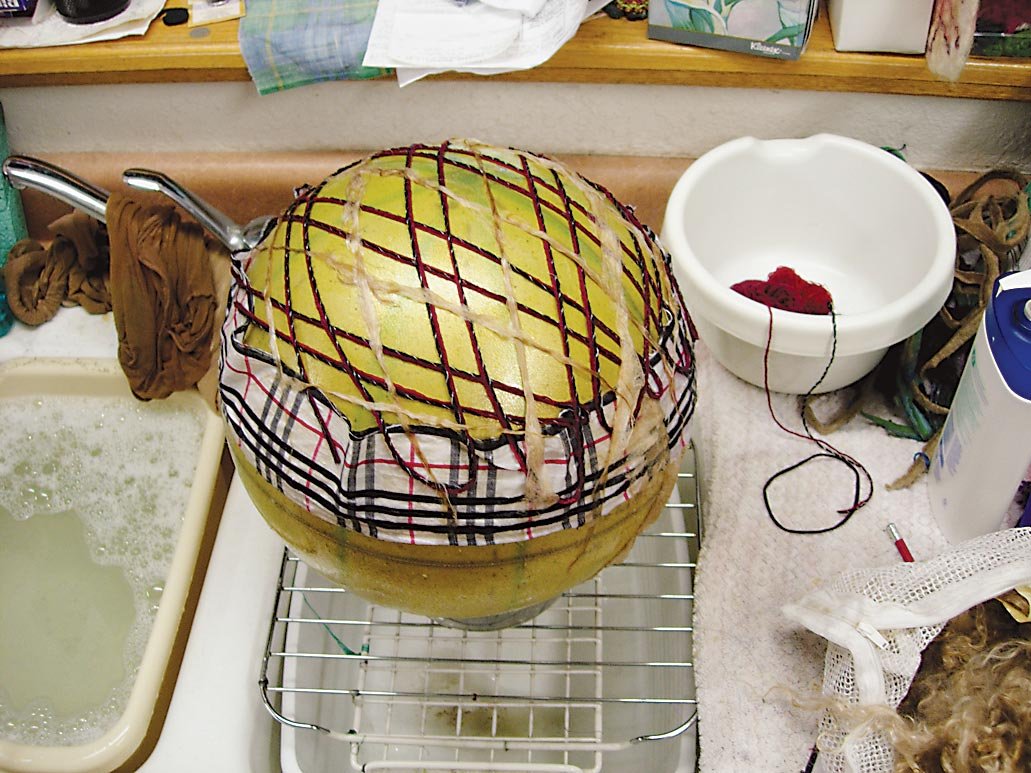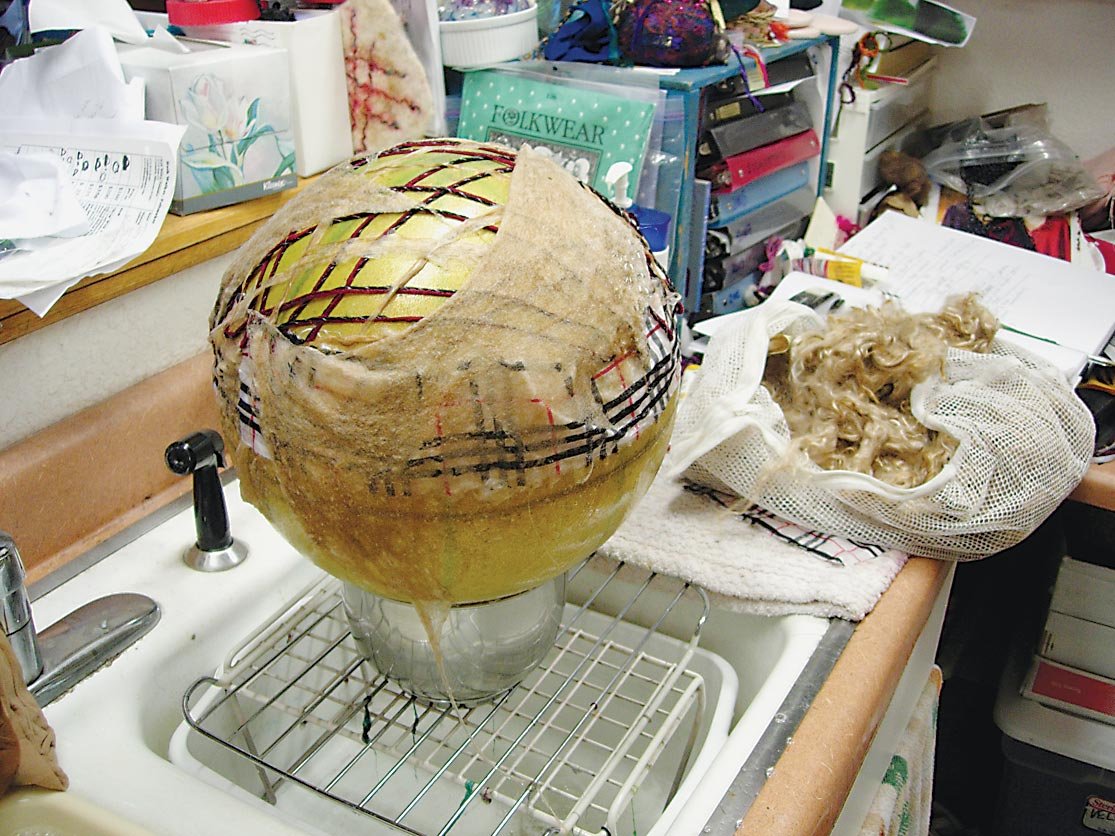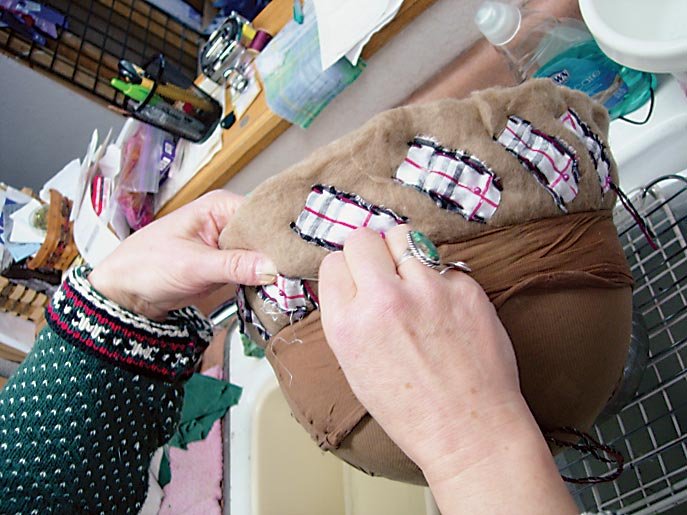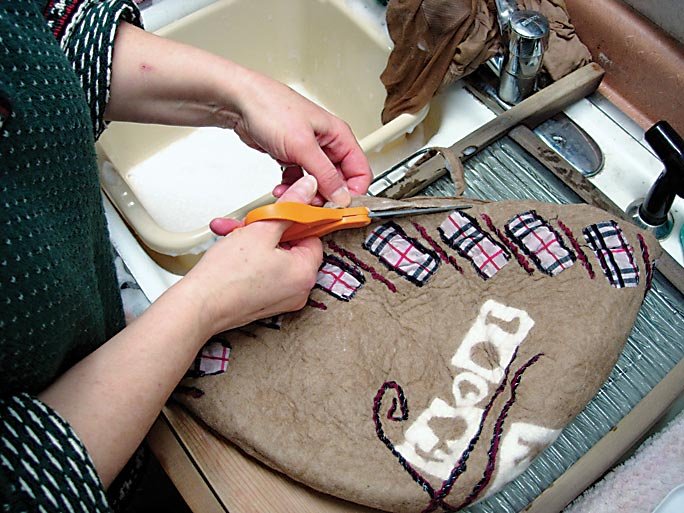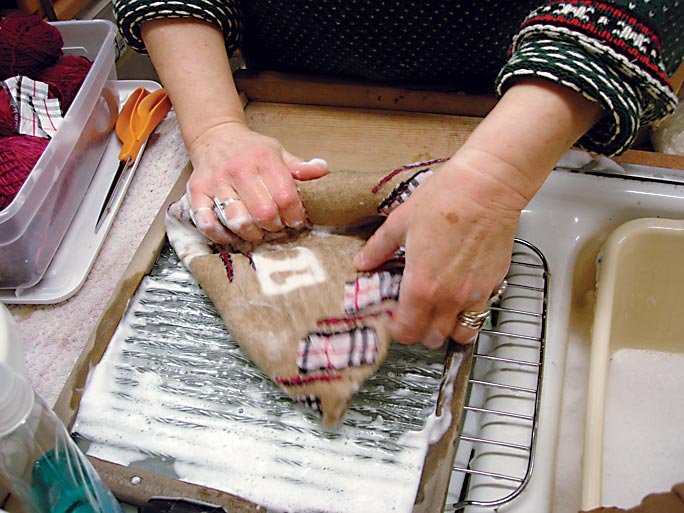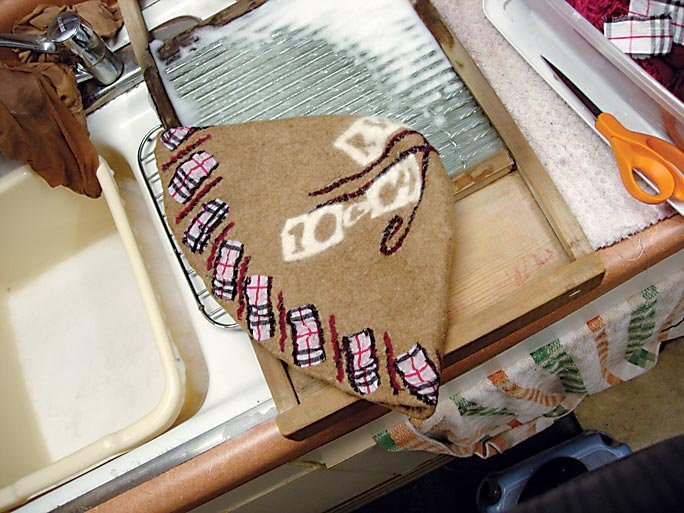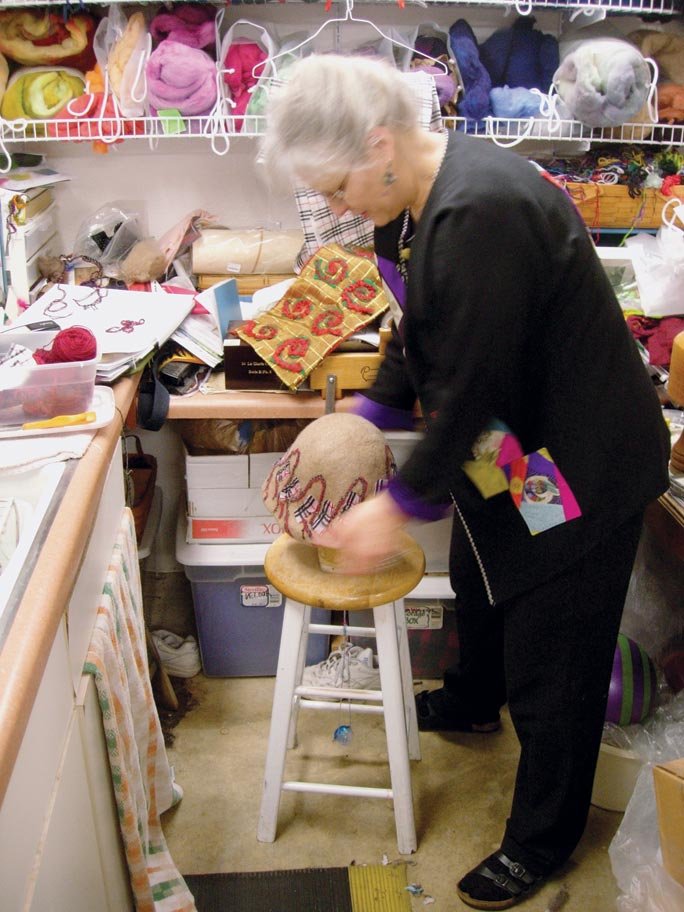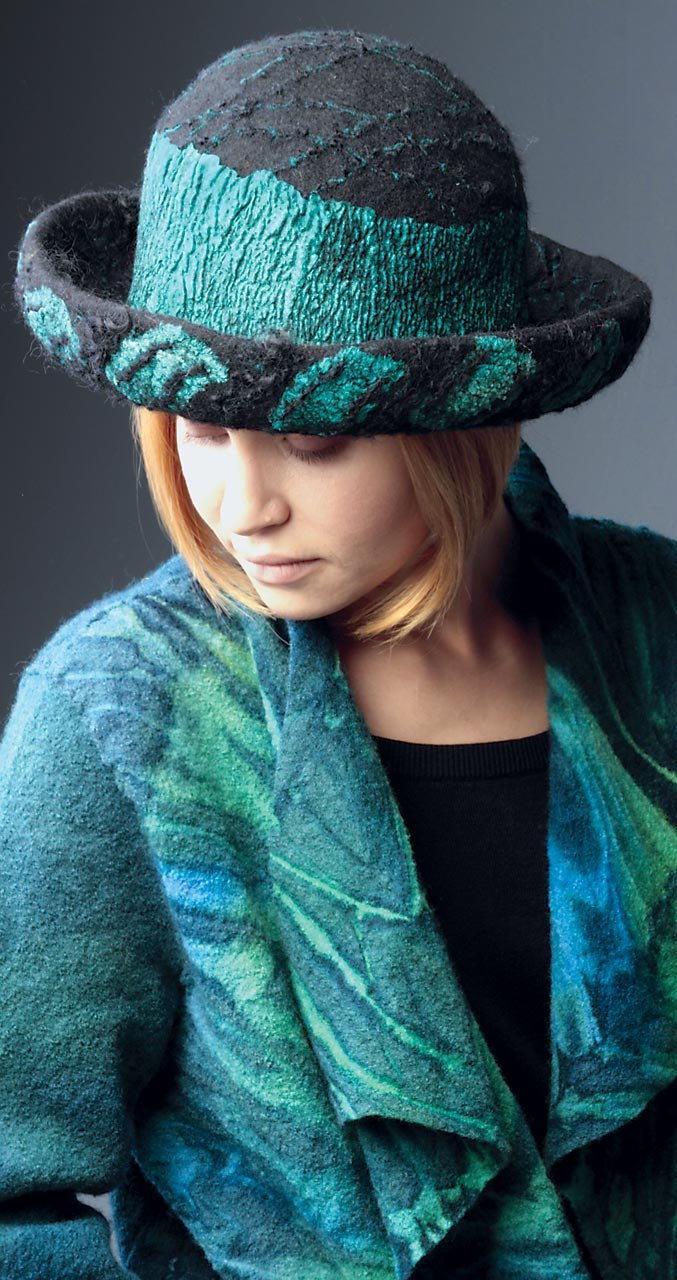Felting a Life Volume 33.3
HAT STACK, conceived by Peter Anger, 2007. Photograph by Helios Studio, Columbia, Missouri.
In 1982 I was barreling along in graduate school when I was distracted by a blanket. I had been studying clathrin-coated vesicles of plant cells. The coat subunit, named after a game floor seen in the original Star Trek series, readily self-assembles to form an attractive spherical basket of hexagons and pentagons. But here I was, transfixed by softly gleaming parallel strands of fibers in the yarns of early Navajo textiles at the Heard Museum, in Phoenix, Arizona. From before the Bosque Redondo, they were woven of lustrous handspun Churro wool. I experienced a tremendous compulsion to do “that.”
Later, in Canberra, Australia, I learned to spin (not that gym-bicycling, please, but real spinning, on a wheel), with wool fleece—and not recycled pop bottles, but a real fleece shorn from an animal, long in staple, shiny and full of fragrant lanolin. They say Australia was built on the back of Merino sheep; certainly its wool smelled truly wonderful and glistened in the light.
Some time after, our small family landed in Columbia, Missouri. I would card wool, comb wool, spin wool, spin more. My two-year-old got her head bonked by the flyer as I treadled; she avoided it thereafter. The fibers ran through my hands as children played on the neighbor’s swing-set or as they took swimming lessons. People asked me, “What do you make?” “She just makes yarn,” my husband would insert. “Then she hangs it on the wall.”
One cold March day my friend, master spinner Sammy Eber taught our spinning group to make felt balls. I grabbed a handful of dyed wool fluff and wrestled it into a sphere by tightly winding with handspun singles yarn (i.e., yarn not plied with another strand). We stuffed our wool wads into stocking toes and squished them in sudsy water; the fibers bound themselves into a cohesive spherical mass. Best of all: the yarn I had wrapped around the mass had been caught up by the wool fibers and pulled into wrinkles, curls, waves.
The very definition of summer here is sunny, 104° F and humid. Sammy introduced us to felting hats on such a day by having us drape carded wool over the surface of a kid’s ball, then drag panty hose around this hilariously fluffy pile. Over it we poured boiling water—in the sun! 104° F! humid!—and began to rub, for hours. Exhausted, I easily concluded I would never repeat that particular experience. On Labor Day weekend, though, I entered my fetching little chapeau of deep red-violet, turquoise and royal blue (embellished with handspun singles yarn) into the Fiber Competition of the Bethel World Sheep & Wool Festival. It won Best of Show, whereupon I decided to give felting another look.
“To many people artists seem
Undisciplined and lawless.
Such laziness, with such great gifts,
Seems little short of crime.
One mystery is how they make
The things they make so flawless;
Another, what they’re doing with
Their energy and time.”
A craftsperson is focused on materials and techniques in solving problems. Determined to work out a system for felting on a ball (a process pioneered in the 1970s by sculptor Beth Beede), I experimented with fibers varying in fineness and length from Andy McMurry’s sheep: Merino (the softest sheep wool) and Romney (a lustrous carpet wool). In 1994 I began taking felting workshops from established felting artists, and I am glad that I waited. When I began studying on my own I did not see anything published that resembled my process. Fortunately, felting can be approached in numerous ways: each shares the use of moisture and some sort of pressure. Everything else can be varied.
Felt has about as much resemblance to sheep as bread has to wheat. The world’s oldest textile, felt is defined as a matted, non-woven material formed of damp wool under repeated compression; additional definitions include “anything that resembles” this, including roofing felt and boiled wool. When I talk about felt, however, I am referring to the first definition.
Only dampened fibers exhibiting “differential frictional effect” will tangle under repeated compressions. This is due to microscales along the wool fibers that look like jaggedly hemmed pencil skirts. When the fiber absorbs moisture it swells, causing the skirts to become slightly A-line. As the dampened fibers are repeatedly compressed, each fiber travels and cannot back up: the swollen fibers tangle by ratcheting around each other.
How much felting is enough? How long does this take? These are good questions. I think we can attempt to answer them by looking at some stages in felt production and what we are aiming for by considering a different medium, that of ceramics. A pot is formed from wet clay of some composition. The pot dries; it is “greenware.” But if that pot were put back into water it would dissolve again into mud. This is akin to the brief felting of fibers: when they dry it will be found those fibers are not only easily distinguishable and will pill readily but can be pulled apart back into their original pile of fluff.
The embellishments for the crown are the first items laid onto the ball; that is, the hat is constructed from the outside in (like many felted rugs). This keeps the crown embellishments from moving around too much during the felting.
All of the wool is applied to the ball as palm-sized fluffs wetted out in Dawn Ultracare and water and slapped onto the ball over the embellishments. The whole wet woolly ball is enclosed in a couple of pair of pantyhose tops.
The brim embellishments are stitched on because this area undergoes repeated shrinkage and stretching during the felting process on the ball. Frequently pliers are also required to pull the needle through.
After the embellishments have felted into the wool, the incipient hat is removed from the ball. At this time I do the last trimming of the edge so that it “heals” during the next stage.
Greenware is baked to become “bisqueware.” It has coherence and will not slough back into muck, but it has limited longevity: it eventually flakes and breaks. Bisqueware, for example, the humble terra cotta planting pot, is akin to fibers that have been worked considerably and seem to have formed a cohesive fabric, yet may show some shape changes and pilling over time.
Subsequent baking, now at an increased temperature, vitrifies the pottery, now known as “stoneware.” The corresponding felt is found in tympani mallets, piano hammers and masterfully felted rugs such as those made by Turkish artist Mehmet Girgic (honored in 2010 by UNESCO as a Living Treasure for his lifelong work as a feltmaker). There are no wrinkles or ripples, there is no sponginess. One further analogy is to vitrified porcelain, which has its felt counterparts in disc brakes and specialty glass-polishing discs.
What one misses in the pottery analogy is that “felt” is actually a continuum from lightly entangled dreadlocks to the extreme density of those polishing discs. The degree of felting depends not only upon the amount of work put into the process (w=f x d) but also wool breed (defining fineness and scale structure), fiber length, even time of year harvested. Still, some wool sullenly resists felting.
If “craftsmanship is based on slow learning and on habit,” as Richard Sennett states in The Craftsman, then almost anyone can become a good feltmaker. I am the poster child for slow learning—ask my eighth grade home economics teacher. Like everything worth doing well it requires desire, tenacity and reflection. I have also had encouragement from my “creativity coach” neighbor, extended family, fellow fiber aficionados, husband (sometimes critically helpful), and customers who had every expectation I could make what they wanted.
Just as the shoemaker had only enough leather for one more pair of shoes until the technically superior elves stepped in, I can only buy wool if I sell my work. I was terrified to face the public until I watched speaker Bruce Baker at a Best of Missouri Hands conference dramatically sweep one arm up and declare, “This is my work.” Yet, it still took the example of other artists interacting with my customers, explaining how versatile and wonderful the hats are, for me to be able to step into the (uncomfortable) promotion of my own work.
I dye the wool myself for intense color and to mothproof it (done with the dyeing), and so that I can buy the wool I want. I am not interested in processed wool over which I have no knowledge or control of quality or color. But dyeing carded wool without felting it is a challenge: hot water facilitates tangling.
The glass washboard is a convenient temporary horizontal surface upon which to roll up the hat and knead it. (Necessary because all the other horizontal surfaces are full of wool and magazines.)
Rock ‘n’ Roll: A “Walker” in German is one who kneads. I do not rub because that would make the felt too fuzzy for my taste.
The hat has shrunk considerably due to the kneading. Evident is its unique inventory number die-cut from needle-felt.
After the hat is rinsed it is steamed in the microwave oven and forcefully jammed onto a long-necked cloth-and-wood wig stand to smooth out the crown. The brim is shaped by hand.
BRIM WITH A TWIST, hand-felted of hand-dyed Merino wool, embedded with hand-dyed silk organza, wool yarns, and Wensleydale wool locks, 2007. Brim nests handspun Merino wool singles yarn. Photograph by Helios Studio.
Chad Alice Hagen describes the care in the initial coaxing of the fibers to intermingle as “caressing a butterfly.” Stitching into the nascent felt follows, nothing intricate, but utilitarian, like hemming up hand-me-downs. The subsequent energetic period entails singing, frequent assessment, then kneading (my favorite part): ever more vigorous yet focused hardening what used to be a pile of fluff into an even, seamless object. Blocking is last, firm stretching of the steamed object into its final shape with practiced adjustments to disguise what is, unavoidably, uneven. One of the principal challenges in making an article of felt is to achieve an even density in the initial layout.
Clearly I am inspired by color, texture and function. Why hats? The ball requires very little space; the project is small enough to complete in a day. (If I would just declutter my studio, there would be much larger work from me.) Why use wool? Well, why ever not? It is comfortable, warm, soft, great insulation; it takes dye beautifully. The felt holds its shape and sheds water. The fiber structure is complex and has this strange ability to form a fabric just by pushing on it: use the right types of wool and it will work every time.
“How long does this take?” is never the right question because the answer can only be “As long as it takes.” It is one’s repetitive, focused motions and not the desultory passage of time that will cause the fibers to entangle. Teaching others helped me define ‘why I do what I do when I do,’ to paraphrase Chris Turk of ABC’s Scrubs.
Although I have felted many hundred of hats in the past eighteen years, I will lose my touch if I slow down, like Balzac’s lazy sculptor in Cousin Bette. “Skill comes from doing,” Bonnie Ahrens quietly asserts. When my children were young I drove them to and from school, the intervening hours occupied in a succession of technician jobs in research laboratories. On the weekends I was frantic to felt. But since about 2000 I have had the great fortune to felt full time, and have filled over two dozen log books with wool and embellishment samples of almost everything I have made since a year spent in Norwich, England.
BRIM WITH A TWIST, hand-felted of hand-dyed Merino wool, embedded with commercial plaid silk douppioni and Lincoln wool locks, 2007. Handspun Targhee wool band nested in brim. Photograph by Helios Studio.
We are the species that embellishes—our bodies, our functional objects, our lives. I share with my mother a love of color and texture—and I would not bother with felting but for the ability to felt in the embellishments. The distortion of a straight yarn into waves distracted me from spinning and weaving. (And the yarn I used to hang on the wall is nested in hat brims.) My father is a brick- and stonemason; very thoughtfully artistic is his work. Regardless of the beauty of a fireplace, he stresses, it has to draw air, it has to function. I focus on craftsmanship to make certain the product will serve its wearer for decades to come.
Altlhough there is no mastery without practice, I share the perspective of violinist Anne-Sophie Mutter: “I never practice; I only play.” Each hat contains in itself a small experiment, a question, and is its own sample, its own practice session as well as being a wearable hat. I orient the fibers this way so I can stretch them that way; I put coarse lustrous fibers on fine matte fibers so the inevitable blend does not appear to muddy the colors. I am always probing and always focused on what I am doing. I only “play.”
Here is what I like: saturated hues (usually), curls, parallel lines, geometric shapes, shine, comfort. I am very interested in processes, and it is important to me to be physically invested in each piece. But it is the freshly shorn wool that I find the most beautiful, with its fragrant, glistening, curving parallel fibers. I closeted myself with this odd entrancement until I read from Thomas Hardy in Far From the Madding Crowd—“The clean, sleek creature arose from its fleece, which lay on the floor in one soft cloud, three-and-a-half pounds of unadulterated warmth for the winter enjoyment of persons far away, who will, however, never experience the superlative comfort derivable from the wool as it here exists, new and pure, rendering it just now as superior to anything woollen as cream is superior to milk-and-water.”
OCEANNA, collaboration of Suza Wooldridge and Ruth Walker, 2009. BRIM WITH A FLIP, hand-felted of hand-dyed Romney X Merino lambswool embedded with hand-dyed silk organza and handspun wool yarn. TWICE-DYED POLE WRAP, boiled wool jacket by Suza Wooldridge, dyed, wrapped, dyed, fulled, sewn. Photograph by Greg Hall. Model: Hannah Reeves.
Ruth E. Wiedenhoeft Walker learned to felt in 1992 from master spinner, knitter and dyer Sammy Eber, as an offshoot of wool spinning and dyeing. She felted and developed some of her techniques in isolation for several years before taking workshops from well-known artists. She has been selling her colorful, hand-felted objects since 1994, and has won recognition for her work in competitions and exhibitions. A research technician in various biology laboratories for many
years, she left life in “the lab” in 1999 to become a full-time studio artist.

